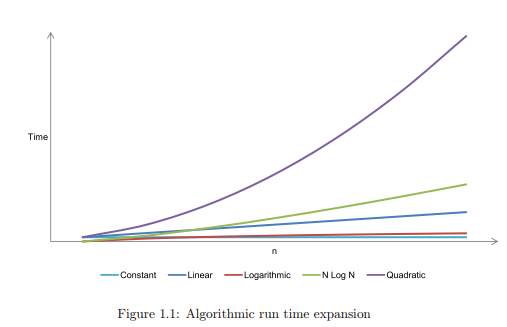

In The last lecture we study about – Big Oh notation
Figure 1.1 shows some of the run times to demonstrate how important it is to choose an efficient algorithm. For the sanity of our graph we have omitted cubic O(n 3 ), and exponential O(2n) run times. Cubic and exponential algorithms should only ever be used for very small problems (if ever!); avoid them if feasibly possible.
The following list explains some of the most common big Oh notations:
O(1) constant: the operation doesn’t depend on the size of its input, e.g. adding a node to the tail of a linked list where we always maintain a pointer to the tail node.
O(n) linear: the run time complexity is proportionate to the size of n.
For more click Here – http://literacybase.com/data-struc-tures-and-algorithms-big-oh-notation/
In this lecture we study about Imperative programming language
All examples are given in a pseudo-imperative coding format and so the reader must know the basics of some imperative mainstream programming language to port the examples effectively, we have written this book with the following target languages in mind:
1. C++
2. C#
3. Java
The reason that we are explicit in this requirement is simple—all our implementations are based on an imperative thinking style. If you are a functional programmer you will need to apply various aspects from the functional paradigm to produce efficient solutions with respect to your functional language whether it be Haskell, F#, OCaml, etc. Two of the languages that we have listed (C# and Java) target virtual machines which provide various things like security sand boxing, and memory management via garbage collection algorithms. It is trivial to port our implementations to these languages. When porting to C++ you must remember to use pointers for certain things. For example, when we describe a linked list node as having a reference to the next node, this description is in the context of a managed environment. In C++ you should interpret the reference as a pointer to the next node and so on. For programmers who have a fair amount of experience with their respective language these subtleties will present no issue, which is why we really do emphasise that the reader must be comfortable with at least one imperative language in order to successfully port the pseudoimplementations in this book. It is essential that the user is familiar with primitive imperative language constructs before reading this book otherwise you will just get lost. Some algorithms presented in this book can be confusing to follow even for experienced programmers!
Nggak Nyangka! Hidup Gue Berubah Total! Gue bukan siapa-siapa. Cuma anak kos biasa yang kerja serabutan buat nutup biaya hidup… Read More
What is the Main Cause of a Heart Attack? What is its Solution? A heart attack is the blockage of… Read More
In the vast economic arena, one term that often takes center stage, inciting extensive debates and discussions, is the "debt… Read More
De-Dollarization: The Changing Face of Global Finance The financial landscape is in a state of flux, with an intriguing economic… Read More
The curtains closed on a dramatic Bundesliga season with Bayern Munich standing tall once again, clinching their 11th straight title.… Read More
The Unfolding Story of Celine Dion's Health In recent news that has left fans across the globe stunned, iconic singer… Read More